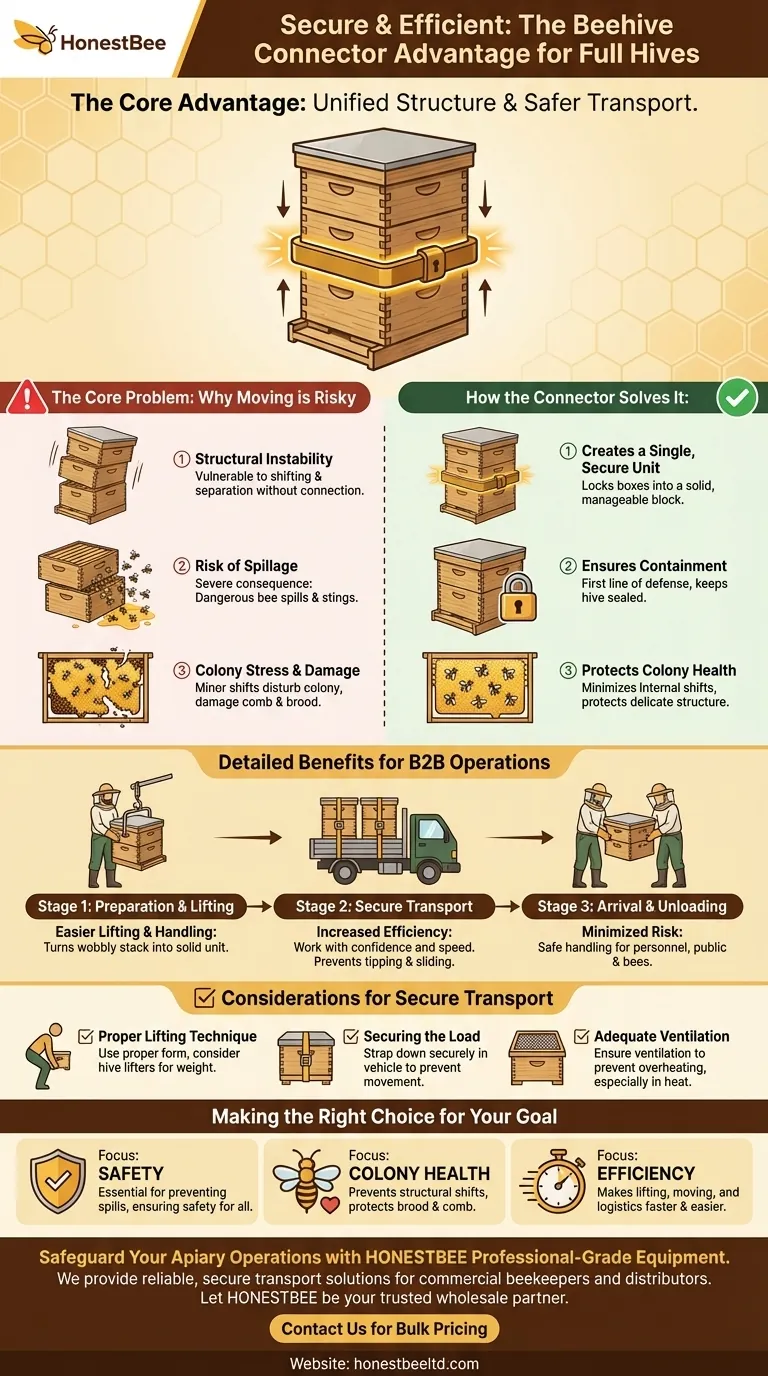The primary advantage of the beehive connector is that it creates a strong, unified structure out of multiple hive components. This secure connection is critical when handling full beehives, as it prevents parts from shifting or separating, making transport significantly safer and more convenient.
The core challenge of moving a full beehive is managing its weight, instability, and containing thousands of live insects. The beehive connector directly solves this by locking the hive components together, transforming a precarious stack into a single, solid unit.

The Core Problem: Why Moving a Beehive is Risky
Transporting a beehive, especially one heavy with honey and bees, presents unique challenges. Understanding these risks highlights the value of a secure connector.
H3: Structural Instability
A standard beehive is a stack of separate boxes: a bottom board, brood boxes, and honey supers. Without a connector, these pieces are held together only by gravity and the bees' own propolis.
This makes the hive vulnerable to shifting during lifting or transport. A sudden jolt can easily cause the boxes to slide apart.
H3: The Risk of Spillage
If hive components separate, the consequences can be severe. Thousands of agitated bees can spill out, creating a dangerous situation for the beekeeper and anyone nearby.
This not only poses a stinging hazard but also results in significant bee loss, which weakens the colony.
H3: Colony Stress and Damage
Even minor shifts can disturb the colony. Frames of comb can be damaged, brood can be chilled, and the overall stress can negatively impact the hive's health and productivity.
A secure connection minimizes this internal disruption, protecting the delicate structure of the hive and the well-being of the bees inside.
How the Beehive Connector Solves the Problem
The beehive connector is engineered to counteract the inherent instability of a stacked hive during transport.
H3: Creating a Single, Secure Unit
The connector firmly locks the individual boxes together. This mechanical bond turns a wobbly stack into a solid, manageable block.
This unified structure is far easier to lift, carry, and secure in a vehicle, dramatically simplifying the logistics of moving the hive.
H3: Ensuring Containment
By preventing the hive boxes from separating, the connector is the first line of defense against bee spills. It ensures the hive remains a sealed container.
This makes the entire process feel more controlled and significantly reduces the risk associated with handling a live colony.
H3: Increasing Transport Efficiency
A secure hive is an efficient hive to move. Beekeepers can work with more confidence and speed, knowing the structure is sound.
This convenience is especially appreciated when moving multiple hives or when working alone.
Considerations for Secure Transport
While the connector is a critical tool, it is one part of a comprehensive approach to safely moving bees.
H3: Proper Lifting Technique
Even with a connector, a full beehive is heavy and awkward. Always use proper lifting techniques, bending at the knees to protect your back. For very heavy hives, a hive lifter or a second person is recommended.
H3: Securing the Load
Once in a vehicle, the hive must be secured with straps to prevent it from tipping or sliding. The connector ensures the hive stays together, while straps ensure it stays in place.
H3: Adequate Ventilation
Bees generate a significant amount of heat. During transport, especially on warm days, you must ensure the hive has adequate ventilation to prevent the colony from overheating. This is often achieved with a screened moving cover.
Making the Right Choice for Your Goal
Your specific goal during transport will determine how you value the beehive connector.
- If your primary focus is safety: The connector is essential for preventing bee spills and ensuring the well-being of yourself and the public.
- If your primary focus is colony health: The connector prevents the structural shifts that can damage comb, harm brood, and cause unnecessary stress to your bees.
- If your primary focus is efficiency: This tool makes the entire process of lifting and moving hives faster, easier, and more convenient.
Ultimately, using a beehive connector provides the confidence and control needed to move your colonies safely and effectively.
Summary Table:
| Problem | Solution with Beehive Connector |
|---|---|
| Structural Instability | Locks boxes together into a single, solid unit |
| Risk of Bee Spillage | Prevents components from separating, ensuring containment |
| Colony Stress & Damage | Minimizes internal shifts, protecting comb and brood |
| Inefficient Transport | Makes hives easier to lift, carry, and secure |
Safeguard your apiary operations with professional-grade equipment from HONESTBEE.
We understand the critical need for reliable, secure transport solutions for commercial beekeepers and distributors. Our beehive connectors are designed to provide the structural integrity and safety your business depends on when moving valuable colonies.
Let HONESTBEE be your trusted wholesale partner for all your beekeeping supply needs.
Contact our team today to discuss bulk pricing and discover how our equipment can enhance the efficiency and safety of your operations.
Visual Guide

Related Products
- HONESTBEE Advanced Ergonomic Stainless Steel Hive Tool for Beekeeping
- Professional Dual-End Stainless Steel Hive Tool for Beekeeping
- Beehive Handle and Frame Rest Cutting Machine: Your Specialized Hive Machine
- Professional 3-Bar Frame Grip with Integrated Hive Tool
- Yellow Plastic Bucket Pail Perch for Beekeeping
People Also Ask
- What are some common uses of a hive tool? Essential Multi-Purpose Tool for Every Beekeeper
- Why is it important to compare the progress of different hives? A Beekeeper's Key Diagnostic Tool
- What tools are used for cleaning frames? A Beekeeper's Simple 4-Tool Guide
- What is the hole in a hive tool for? A Multi-Tool for Apiary Repairs and Maintenance
- Why do hive tools have a hole? Unlock the Secret to Efficient Beekeeping



















